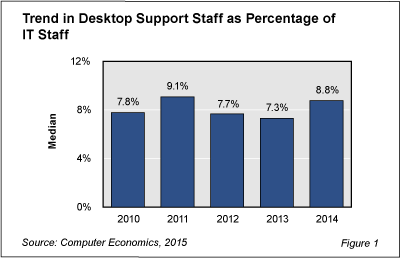While the venerable PC may have lost some of its luster, the number of technicians an IT organization needs to support users with their PCs and other technologies has remained relatively consistent over the past five years.
Desktop support staff as a percentage of IT staff rebounded to 8.8% at the median in 2014, after undergoing some seemingly erratic ups and downs during the recovery period, as shown in Figure 1 from our study, Desktop Support Staffing Ratios. In short, the function remains as prevalent and important as ever on the typical IT staff today.

In Figure 1, we see that the desktop support staff across all sizes of organizations at the median hit a high of 9.1% in 2011. But as the recovery strengthened, desktop support staffing appears to have declined to 7.7% in 2012 and 7.3% in 2013. The decline turns out to be more cyclical than secular. It may be due to renewed hiring in other IT staffing categories such as application development, data management, and networking than any decline in the ranks of desktop support technicians.
Over the longer-term, the 8.8% median in this ratio in 2014 falls on the high side of a range that has hovered around the 8% level, and the trend line is not showing any sign that technological advances or shifts toward the cloud are reducing the need to provide end-users with technical support for their equipment.
Compared with the early days of the PC, today’s desktop computers are more reliable, users more knowledgeable, and web applications less troublesome than the fat-client systems. Yet these machines still require a great deal of support to maintain high levels of user satisfaction and productivity, and the need for mobility, security, and connectivity still generate calls for help.
The full study provides benchmarks on typical desktop support staffing. We use two metrics to benchmark desktop support staffing: desktop support staff as a percentage of the IT staff and PCs per desktop support staff member. We also assess these ratios by organization size and sector. In addition, we provide benchmarks for organizations with combined desktop support and help desk functions. We conclude with strategies for improving the efficiency of desktop support staff.
The term “desktop support” requires definition. In some organizations, desktop support refers to personnel who are present on-site to help users with PCs, network connectivity, telephones, and perhaps other equipment. Other organizations consider desktop support as a Level II help desk function. Still other organizations have distinct help desk and desktop support groups, each with multiple tiers. We use a functional definition. Regardless of whether they are located in a distant call center or are available at the client’s desk, desktop support staff members assist users with issues related to PC hardware and operating systems, although they often provide support for other systems as well. While organizations preferring a higher level of service may choose to deploy more on-site support, desktop support technicians can handle many issues from remote locations today.
This Research Byte is a brief overview of our report on this subject, Desktop Support Staffing Ratios. The full report is available at no charge for Computer Economics clients, or it may be purchased by non-clients directly from our website (click for pricing).
Do you also need staffing ratios for other IT job functions? Consider this collection of all of our staffing ratio reports, which bundles them all into a single report at a significant discount: IT Staffing Ratios–Special Report Bundle.

